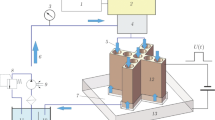Abstract
To determine the relationship between the pulse current and the physicochemical properties of multi-time scales, a method of multi-time scale simulation is introduced to investigate multi-time scale evolution of temperature and void fraction in PECM process. A multi-time scale iterations method is introduced to reduce computation time of multi-time scale simulation. Simulation results indicate that the method is efficient and pulse current can make the PECM process more stable. Experimental results show that the multi-time scale simulation results can well match the actual machining results, especially in the middle section of the workpiece.












Similar content being viewed by others
References
Weber O, Natter H, Bähre D (2015) Pulse electrochemical machining of cast iron: a layer-based approach for modeling the steady-state dissolution current. J Solid State Electrochem 19:1265–1276
Zhu D, Gu ZZ, Xue TY, Liu A (2017) Simulation and experimental investigation on a dynamic lateral flow mode in trepanning electrochemical machining. Chin J Aeronaut 30(4):1624–1630
Wang DY, Li JZ, He B, Zhu D (2019) Analysis and control of inter-electrode gap during leveling process in counter-rotating electrochemical machining. Chin J Aeronaut 32(11):2557–2565
Rajurkar KP, Wei B, Kozak J (1995) Modelling and monitoring interelectrode gap in pulse electrochemical machining. CIRP Ann Manuf Technol 44(1):177–180
Kozak J, Rajurkar KP, Wei B (1994) Modeling and analysis of pulse electrochemical machining. J Eng Ind 116(3):316–323
Kozak J (2004) Thermal models of pulse electrochemical machining. Bull Pol Acad Sci: Tech Sci 52(4):313–320
Kozak J (2013) Simulation of electrochemical shaping of airfoils using continuous and pulse current. In: Ao SI, Douglas C, Grundfest WS, Burgstone J (eds) Proceedings of the world congress on engineering and computer science. USA, San Francisco, pp 23–25
Smets N, Van Damme S, De Wilde D, Weyns G, Deconinck J (2007) Calculation of temperature transients in pulse electrochemical machining (PECM). J Appl Electrochem 37(3):315–324
Smets N, Van Damme S, De Wilde D, Weyns G, Deconinck J (2007) Time averaged temperature calculations in pulse electrochemical machining, part I: theoretical basis. J Appl Electrochem 37(11):1345–1355
Smets N, Van Damme S, De Wilde D, Weyns G, Deconinck J (2008) Time averaged temperature calculations in pulse electrochemical machining, part II: numerical simulation. J Appl Electrochem 38(4):551–560
Smets N, Van Damme S, De Wilde D, Weyns G, Deconinck J (2010) Time averaged temperature calculations in pulse electrochemical machining, using a strongly non-linear model. J Appl Electrochem 40(7):1395–1405
Chen YL, Fang M, Jiang LJ (2017) Multiphysics simulation of the material removal process in pulse electrochemical machining (PECM). Int J Adv Manuf Technol 91(5–8):2455–2464
Thorpe JF, Zerkle RD (1969) Analytic determination of the equilibrium gap in electrochemical machining. Int J Mach Tool Des Res 9(2):131–144
Shives M, Crawford C (2016) Adapted two-equation turbulence closures for actuator disk RANS simulations of wind & tidal turbine wakes. Renew Energ 92:273–292
Deconinck D, Van Damme S, Deconinck J (2012) A temperature dependent multi-ion model for time accurate numerical simulation of the electrochemical machining process, Part I: Theoretical basis. Electrochim Acta 60:321–328
Fang XL, Qu NS, Zhang YD, Xu ZY, Zhu D (2014) Effects of pulsating electrolyte flow in electrochemical machining. J Mater Process Technol 214(1):36–43
Deconinck D, Van Damme S, Albu C, Hotoiu L, Deconinck J (2011) Study of the effects of heat removal on the copying accuracy of the electrochemical machining process. Electrochim Acta 56(16):5642–5649
Funding
This work has been financially supported by the National Natural Science Foundation of China [grant number 51775161], the Scientific Research Foundation of Anhui Poly-technic University [grant number Xjky019201903], the Scientific Research Foundation for the introduction of talents of Anhui Poly-technic University [grant number 2018YQQ003], and the Fundamental Research Funds for the Central Universities of China [grant number JD2019JGPY0015].
Author information
Authors and Affiliations
Corresponding author
Additional information
Publisher’s note
Springer Nature remains neutral with regard to jurisdictional claims in published maps and institutional affiliations.
Rights and permissions
About this article
Cite this article
Yuanlong, C., Lijun, J., Ming, F. et al. Multi-time scale simulation of pulse electrochemical machining process with multi-physical model. Int J Adv Manuf Technol 110, 2203–2210 (2020). https://doi.org/10.1007/s00170-020-06017-y
Received:
Accepted:
Published:
Issue Date:
DOI: https://doi.org/10.1007/s00170-020-06017-y




